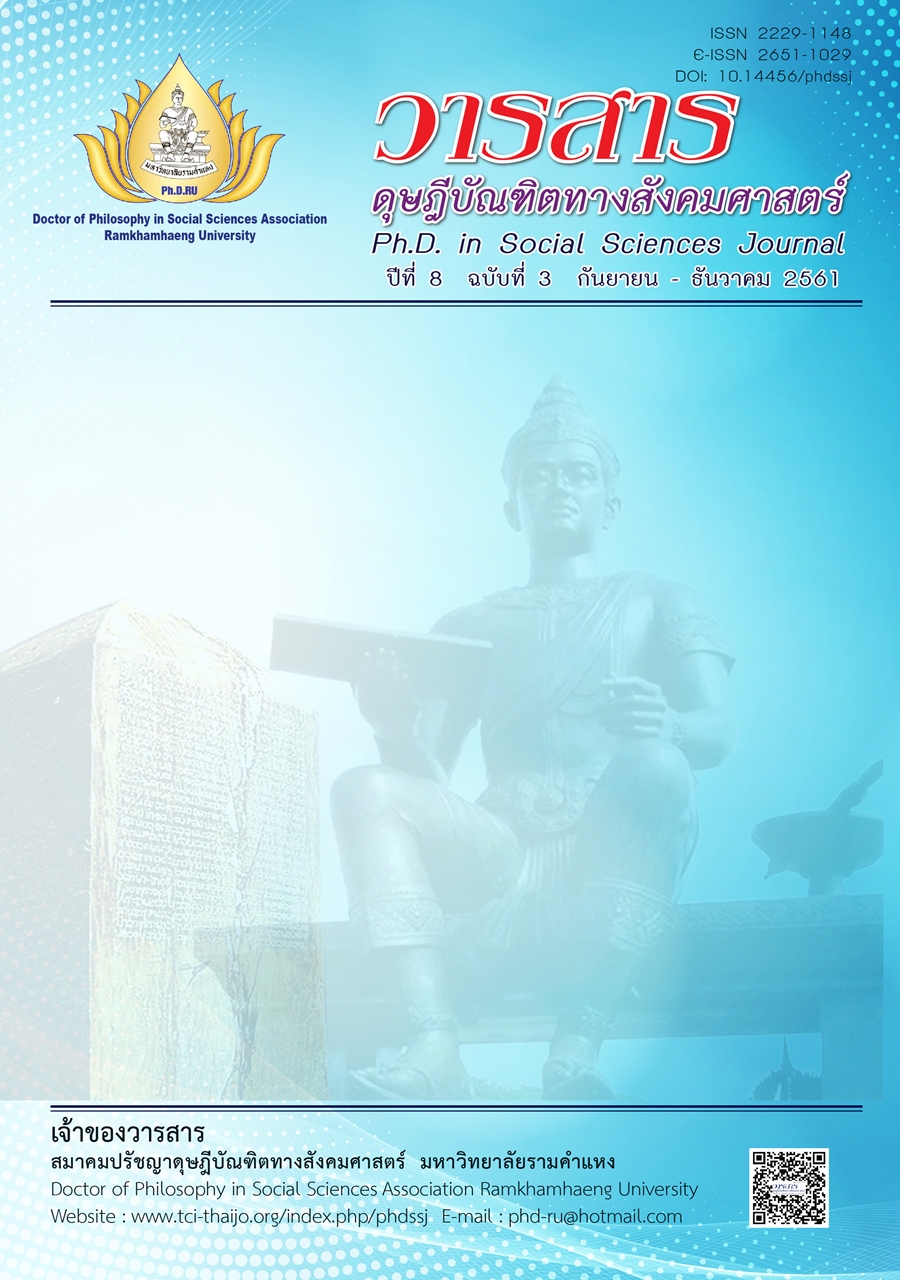Haze Problem Policy Networks in Doi Tung Development Project (Royal Workspace) Founded and Sustained by Princess Srinagarindra, The Princess Mother of The Kingdom of Thailand
Main Article Content
Abstract
In this research, the researcher examines (1) the operation of haze problem policy networks in Doi Tung development project, (2) the analyzing of participants and the haze problem policy networks interaction in Doi Tung development project. The researcher also frames the social phenomenon by qualitative research.
Findings are as follows:
The operation of haze problem network has coordinate from the government, private and public sector. The most interaction of implement or drive the policy to protect and solve the haze problem is the informal relationship that focus on personal relationship and communication meeting between stakeholders or haze problem policy networks members.
Article Details
Academic articles, research articles, and book reviews in the Ph.D. in Social Sciences Journal are author’s opinions, and not the publisher’s, and is not the responsibility of the Ph.D. in Social Sciences Journal Philosophy Association, Ramkhamhaeng University. (In the case that research is done on human, the researcher has to be trained in Ethics for Doing Research on Human Training and has to produce the evidence of the training).
References
Boontian, S. (2012). Patterns of participatory public policy formulation by area healthy assembly. Humanities and Social Sciences, 29(2), 133-163. [In Thai]
Charoensiri, J. (2013). Local network organization with participation: Case studies of Kok Hinlard community forest and Kok Nong No community forest, Maha Sarakham province. Master's thesis public administration, National Institute of Development Administration. [In Thai]
CharoenWongsak, K. (1994). Strategies for success in educational reform. Bangkok: Succuss Media. [In Thai]
Cook, K. S. (1977). Exchange and power in networks of interorganizational relations. The Sociological Quarterly, 18(1), 62-82.
Dye, T. R. (2008). Understanding public policy. Englewood Cliffs, NJ: Prentice Hall.
Edwards, G. C., & sharkansky, I. (1978). The policy predicament: Making and implementing public. San Francisco, CA: W. H. Freeman.
Harnkiattiwong, T., Thammahot, R., Chardchawarn S., & Dejanipont, T. (2017). Networks for priventing the problem of haze in the lepper Northern Region. Ph.D. in Social Seiences Journal, 7(3), 41-53.
Kenis, P., & Scneider, V. (1991). Policy networks and policy analysis: Scrutinizing a new analytical toolbox. In B. Marin & R. Mayntz (Eds.), Policy networks, empirical evidence and theoretical considerations (pp. 25-59). Frankfurt, Germany: Campus Verlag.
Kim, D. W. (2001). Intelligent transportation systems: A multilevel policy network. Ph.D. dissertation public administration and policy, Virginia Polytechnic Institute and State University.
Kruathep. V. (2007). Network: Innovation of local government working. Bangkok: Research Fund (TRF). [In Thai]
Luzi, S., Abdelmoghny, H. M., Sigrist, F., & Tauchnitz, E. (2008). Water policy networks in Egypt and Ethiopia. The Journal of Environment Development, 17(3), 238-268.
Mazmanian, D. A., & Sabatier, P. A. (1983). Implementation and public policy: With a new postscript. Glenview, IL: Scott Foresman.
Meloney, W. A., Jordan, G., & McLaughlin, A. M. (1994). Interest groups and public policy: The insider/outsider model revisited. Journal of Public Policy, 18(1), 17-38.
Menahem, G. (1998). Policy paradigms, policy networks and water policy in Israel. Journal of Public Policy, 18(3), 283-310.
Pholsri, S. (2007). Learning network in community development (2nd ed.). Bangkok: Odeon Store. [In Thai]
Phothisita, C. (2009). Science and art of qualitative research (4 th ed.). Bangkok: Amarin Printing. [In Thai]
Pollution Control Department. (2010). Report on Thailand’s Pollution Situation in 2008. Bangkok: Author. [In Thai]
Pollution control department. (2011). Report on Thailand’s pollution situation in 2010. Bangkok: Author. [In Thai]
Rhodes, R. A. W. (1988). Beyond Westminster and Whitehall: The sub-central government of Britain. London: Unwin Hyman.
Rhodes, R. A. W. (2006). Policy networks analysis. In M. Moran, M. Rein, & R. E. Goodin. (Eds.), The Oxford handbook of public policy (pp.425-447). New York: Oxford University Press.
Smith, M. J. (1992). The agricultural policy community: Maintaining a closed relatoinship. In D. Marsh & R. A. W. Rhodes (Eds.), Policy networks in British government (pp.27-50). New York: Oxford: Clarendon Press.
Smith, M. J. (1993). Pressure, power and policy: State autonomy and policy networks in British and the United States. New York: Harvester Wheatsheaf.
Suwannasoon, P. (2012). Pollution from the haze in the northern region: Problems and guidelines. Research and Development Papers, 11(117), 23-29. [In Thai]
THanariyawong, P. (2003). Nong Hoi Village disaster management network, Thon Hong district, Phrom Khiri district, Nakhon Sri Thammarat. Academic Services Journal, Prince of Songkla University, 24(1), 51-71. [In Thai]
Unthongdee, N. (2013). Public participation in prevention and solution of haze air pollution in Mae Hong Son province. Master's thesis science, National Institute of Development Administration. [In Thai]
Waarden, F. V. (1992). Dimensions and types of policy networks. European Journal of Political Research, 21(1-2), 29-52.
Yenying, S. (2017). Tap water management of local government in Samuth Phakran province. Public and Private Management Innovation Journal, 5(2), 125-142. [In Thai]


